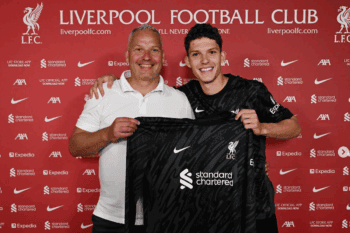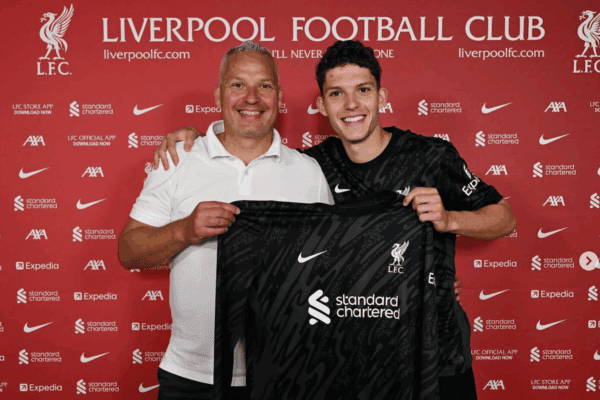Following Liverpool’s club-record signing of RB Leipzig midfielder Naby Keita, Andrew Beasley assesses how the Guinean will fit in at Anfield.
The 22-year-old midfielder enjoyed his first taste of the big leagues with Leipzig last season. He scored eight goals and assisted a further seven which helped power his side to second in the Bundesliga.
It was a great season, and Liverpool supporters can now await his arrival in 2018.
Let’s take a look at his stats from last season in the familiar radar format. Please note, the template for this radar is for central and defensive midfielders, so I have only looked at his 22 starts in that position.
This means that seven starts, one goal and three assists are excluded, but we want to get as accurate a picture as we possibly can.

His versatility is obviously an asset but he will surely play in a central midfield role at Liverpool, not least as he has only played 10 games in attacking midfield across his whole career. Here’s his radar:

It’s a mixture of extremes, and probably not as impressive as you might have assumed. Let’s address some of the potential issues that this image highlights.
Keita didn’t complete many long balls last season, but was he asked to play them?
They’re certainly less common in the Bundesliga; when the 98 teams from Europe’s big five leagues are ranked on long balls per game, only two German sides make the top 20.
Only two players from central and/or defensive midfield in the big leagues, Toni Kroos and Xabi Alonso, averaged more accurate long balls per 90 minutes played than Liverpool captain Jordan Henderson too, so there might not be a need for Keita to regularly play them anyway.
The other main issue would appear to be Keita’s foul rate, but it may not be as bad as it first appears.
Fouls are awarded more often in Germany than they are in England; the rate was 14.3 per team per game in the Bundesliga in 2016/17, compared with 11.4 in the Premier League.

I made this point when Emre Can signed in 2014, and predicted that his foul rate would drop from 1.8 to 1.26 per game in his first season in England, and it actually dropped to 1.1.
This won’t all have been down to a change in leagues, but it can’t be a complete coincidence that Can’s tackle rate increased either, from 2.6 per game at Leverkusen to 2.9 in 2014/15.
Not all fouls are attempted tackles, of course, but fewer attempted tackles appear to be penalised as fouls in Germany. There were 1.3 tackles per foul in the Bundesliga last year, but 1.5 in England.
At Liverpool, I fully expect Keita’s fouling rate to drop purely due to the different nature of the football in this country.

Speaking of tackles, the radar suggests that it is one of his strengths. It will need to be too, as Klopp demands intensity and physicality from his team.
In researching this article, I discovered that the Reds were ranked 36th for tackles per game across the top leagues last season. However, they also tended to dominate the ball too, and averaged the seventh-highest possession figure across the continent.
This means that when you factor in possession, Liverpool in fact averaged the second-most tackles (pro rata) of the 98 teams in England, France, Germany, Italy and Spain.
It’s just as well that Keita averages a lot of tackles if he’s going to be joining the Reds’ engine room.

Interceptions are another apparent strength of Keita, but I would definitely take his statistical performance with a pinch of salt.
When assessing how the teams in the big leagues are ranked on this stat, you’ll see why.

Opta must presumably log interceptions differently in Germany, but even so Klopp will hope that Keita is capable of adding this skill to his midfield.
Only Spurs averaged fewer interceptions per game than the Reds in the 2016/17 Premier League, and while Liverpool had the seventh-highest possession average in the big leagues, the six teams above them all made more interceptions.
I have no concerns over the legitimacy of Keita’s dribbling stats though; only Bayern and Dortmund from Germany make the top 30 dribbling sides in the big leagues, and Bundesliga teams average 8.1 per game compared to 9.8 by their Premier League counterparts.
The radar shows him meeting the outer limit of 2.1 completed dribbles per 90 minutes played, but in fact he averaged three, and only Mousa Dembele of Spurs averaged more from central midfield in the big leagues last year.

It seems that dribbling might well be an asset that Liverpool’s transfer committee have targeted this summer.
It is a strength of recent signing Mohamed Salah, and much like Keita, Alex Oxlade-Chamberlain‘s dribbling stats are off the radar chart too.
Perhaps Klopp and Co. have identified they needed more men who can get past an opponent and slice through a packed defence?
Whether dribbling ability is a stat that the club are looking to with their recruitment or not, it’s certainly one of Keita’s strengths. As the figures here show, it’s certainly not the only one.
















Fan Comments